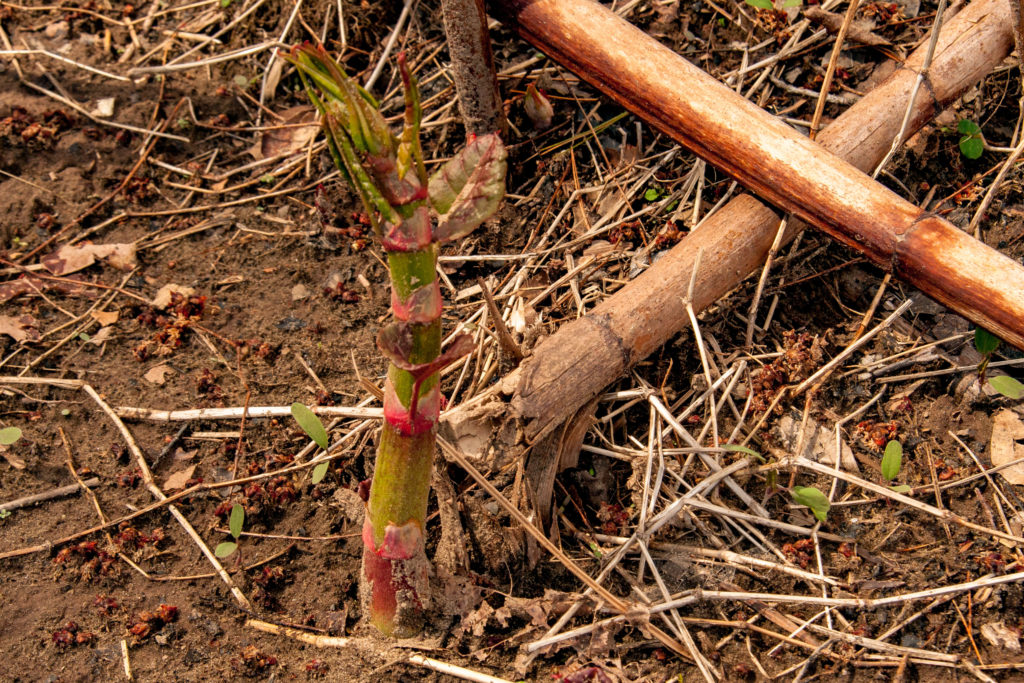
Japanese knotweed (aka Fallopia japonica) is a prolific and aggressive weed, and most gardeners hate it with a white-hot, searing passion. Not me. I celebrate a good patch of Japanese knotweed. It grows in sun or shade, in roadside ditches, on steep embankments, in wet soils, back yards, city parks, and up through sidewalk cracks. In other words, it’s hard to find someplace knotweed DOESN’T grow, unless you’re in the desert southwest or southernmost Florida.
Because it’s a fast growing plant, knotweed was used for creating windbreaks and stabilizing eroding roadsides in the 70s and 80s. Environmentalists realized too late that this was a big mistake. It’s now illegal to plant knotweed anywhere in the U.K., and parts of the U.S. are following suit. Knotweed spreads by underground stolons, and also produces thousands of seeds per plant. In Darwinian terms, it’s a very successful plant. F. japonica ‘variagata’ is an ornamental cultivar with a less aggressive growth habit, but still, if you plant it in your garden, keep an eye on it.
When you’re scouting for knotweed, look for last year’s dried, brown stalks. These will be five or six feet tall and easy to spot. Check the base of the old stalks for young spears. Depending on whether they grow in sun or shade, they’ll have varying degrees of red on the stems. (More sun = more red variegation.)
When knotweed matures it gets tough and fibrous and requires peeling. Since I’m a lazy forager, I harvest young, tender stalks that don’t require peeling. You may have read that only the very short, young stalks of knotweed are suitable for eating, but this isn’t true. If you can easily snap off the top of the stem (with a satisfying pop), you’re good to go. If it’s too tough to snap by hand, check further up the stem for a spot tender enough to break.
Stems may be as thick as your thumb or as slim as a pencil. In less than half an hour you can easily pick five or six pounds of knotweed, enough for a batch of wine, some excellent cocktails, soup, pickles, stir fries, and a couple of desserts. Some people compare the flavor of knotweed to sorrel (using it as a vegetable), others compare the taste to rhubarb (using it in desserts). I do both.
Knotweed keeps for months in the freezer, without blanching. You can use thawed knotweed for soups, wine, and in some dessert recipes, but pickles and stir fries are better with fresh, snappy stems.
I look forward to the knotweed harvest every spring, knowing how easy it is to preserve large quantities of it, and understanding that it’s ok to be greedy with this plant. Japanese knotweed is one plant you probably couldn’t eradicate if you tried.
How do you make Japanese Knotweed tea?
I’m not sure exactly what you mean by tea, because I usually think of teas (or infusions) as being made by pouring water over tender leaves or flowers. Since young knotweed stems have more substance, they need to be decocted, i.e. simmered in a minimal amount of water for 5-10 minutes. Put the young, washed and trimmed stems in a pan and add just enough water to prevent scorching. Bring to a simmer, and cook until the stems are soft enough to mash with a potato masher, then strain through cheesecloth or a jelly bag. The result is more juice than tea, but that’s what I do. If you mean something different, please let me know!
fam mates have just started incorporating j knotweed in our food and the smell is amazing , would you know of any way to make an incense or something ? I’ve been looking around the internet and not finding much . Thanks
Sorry, Salem, I’ve never made incense and have no idea how to make it with Japanese knotweed or anything else! Good luck with your project and sorry I can’t help.